To preserve your fruitcake using brandy, you'll need to start right after baking. First, wrap the cooled cake in brandy-soaked cheesecloth, then cover it tightly with plastic wrap and aluminum foil. Store your wrapped cake in a cool, dark place and feed it with 1-2 teaspoons of brandy every 1-2 weeks. This traditional method requires aging for 1-3 months to develop rich flavors, though some enthusiasts age their cakes for up to a year. For long-term storage, keep the cake in the refrigerator for up to two months or freeze it after the initial aging period. The art of proper fruitcake preservation holds many more time-honored secrets and techniques.
Understanding Traditional Fruitcake Preservation
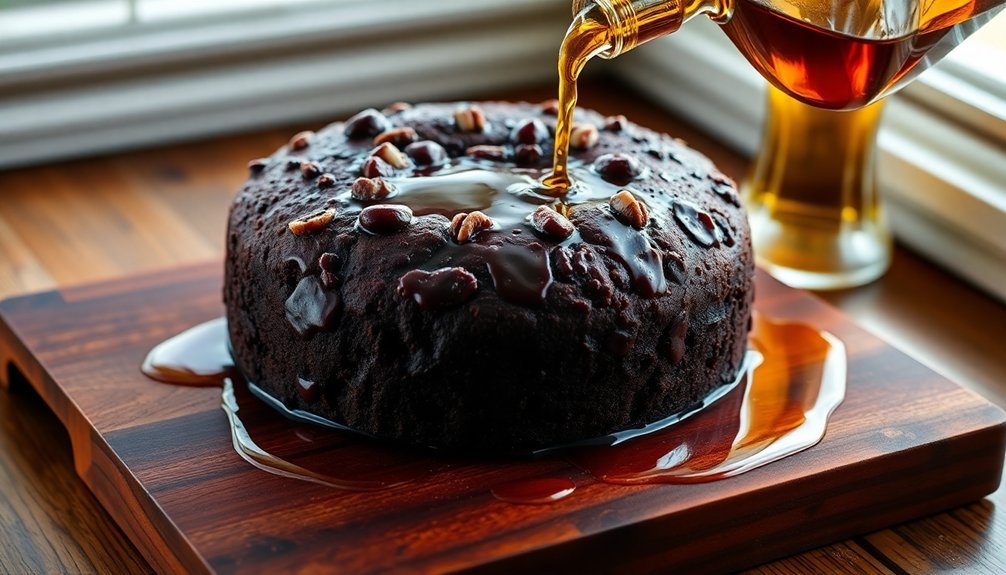
Three key elements define traditional fruitcake preservation: aging, proper storage, and upkeep.
When you've baked your fruitcake, you'll need to age it for one to three months in a cool, dry place to achieve the best flavor and texture. During this aging process, you'll wrap the cake in brandy-soaked cheesecloth and need to reapply the liquor weekly. The alcohol in brandy kills harmful bacteria while preserving moisture.
You'll want to store your fruitcake properly to guarantee its longevity. After aging, you can keep it in the refrigerator wrapped tightly, or for extended storage, wrap it in liquor-soaked cheesecloth followed by foil and place it in an airtight container.
If you're planning to freeze your fruitcake, make sure it's aged for at least four weeks first, and plan to consume it within a year.
Upkeep is essential throughout the preservation process. You'll need to check the cheesecloth regularly to prevent it from drying out and add more brandy as needed.
Using a spray bottle helps distribute the liquor evenly. When properly maintained, your fruitcake can last for months or even years, though it's best consumed within the first year.
Selecting Quality Brandy
Now that you understand the preservation process, selecting the right brandy will make or break your fruitcake's success. While Cognac offers a premium choice with complex flavors, you'll find that quality rum or bourbon can also deliver excellent results. Consider your budget and desired flavor profile when making your selection. Regular sprinkling of brandy helps ensure proper preservation.
When choosing brandy, opt for aged varieties like VSOP, which has matured for at least four years. You'll want to avoid young brandies that can taste harsh and won't mellow properly during the aging process.
Look for reputable brands that offer consistent quality and balanced flavor profiles that'll complement your fruitcake's fruits and spices. Pay attention to the alcohol content, as higher-proof brandies work better for preservation but might need dilution.
If you're unsure about which brandy to choose, don't hesitate to read reviews or seek recommendations from experienced bakers. While premium brandies often command higher prices, they'll typically deliver superior results in both flavor and preservation quality.
Remember that you'll be using this brandy throughout the aging process, from soaking dried fruits to weekly feedings, so choose a brandy you trust.
Essential Tools and Materials

You'll need several basic tools to properly preserve your fruitcake with brandy, including cheesecloth for wrapping, a sharp prod or skewer for making absorption holes, and a spray bottle for even distribution of the liquor.
Double greaseproof paper is essential for properly insulating the cake during the preservation process.
For storing your brandy separately, keep it in an airtight container to maintain its quality throughout the aging process.
Don't forget to have clean zip-top bags or cellophane bags ready to protect your wrapped fruitcake from external flavors and maintain proper moisture levels during storage.
Basic Equipment Needed
Successful preservation of fruitcake with brandy requires a specific set of essential tools and materials before you begin.
You'll need wrapping materials including cheesecloth for soaking in brandy, plastic wrap, aluminum foil, and greaseproof paper to guarantee proper sealing and storage. Don't forget to have airtight containers ready for long-term storage.
For the baking process, you'll require a large mixing bowl, whisk, measuring cups, and spoons for precise ingredient measurements.
Make sure you've got non-stick spray and parchment paper for your loaf pans, plus a toothpick to check when your cake is done.
The aging and feeding process calls for specific tools: a skewer to make holes in the cake, a small spray bottle for even brandy distribution, and a spoon for applying brandy syrup.
If you're making an alcohol-free version, you'll need a saucepan for steaming.
Your storage setup should include a cool, dry area for aging, plus access to a refrigerator or freezer for extended storage periods.
You'll want tin foil as an outer protective layer when freezing, and plates or trays for cooling and serving your preserved fruitcake.
Liquor Storage Containers
Proper storage containers play an essential role in preserving brandy-soaked fruitcakes. You'll need several specific types of containers to guarantee your fruitcake stays moist and flavorful throughout the aging process. Glass mason jars are ideal for storing your brandy syrup and soaked fruits, while airtight plastic containers protect your finished cake.
| Container Type | Primary Use | Key Benefits |
|---|---|---|
| Glass Jars | Liquor & Fruit Storage | Prevents flavor transfer |
| Spray Bottles | Brandy Application | Even distribution |
| Plastic Containers | Cake Storage | Airtight seal |
| Storage Bags | Short-term Storage | Space-saving |
| Mason Jars | Brandy Syrup | Easy pouring |
For the best results, you'll want to keep your brandy in a clean glass container with a tight-fitting lid. When selecting a spray bottle for liquor application, choose a small, food-grade bottle that provides consistent misting. Your main storage container should be large enough to accommodate the fruitcake wrapped in cheesecloth and foil without crushing it. Remember to store your liquor-soaked fruits in glass jars that are completely filled to keep the fruit submerged, topping off with additional brandy as needed.
Preparing Your Fruitcake
The art of preparing a fruitcake begins with careful attention to both ingredients and technique.
You'll want to start by combining your dried fruits, including raisins, currants, candied cherries, apricots, prunes, and figs in a large container. Add nuts and citrus zest to enhance the flavor profile, ensuring everything's evenly distributed.
When you're ready to make the batter, cream your butter and sugar until they're light and fluffy. Add eggs one at a time, incorporating each fully before adding the next. Pour in your brandy and oil (or oil substitute), then prepare your dry ingredients separately.
You'll need to whisk together your flour, baking powder, salt, and spices before combining them with the wet mixture.
For baking, you'll need to prepare your pan meticulously. Line an 8-10 inch cake pan with parchment paper, creating a collar above the rim if needed. Don't forget to grease the pan thoroughly.
Set your oven between 275°F and 325°F, and once you've filled your pan with batter, you can decorate the top with whole nuts. You'll need to bake for 1-2.5 hours, using a water bath if your recipe calls for it.
The Initial Brandy Soak
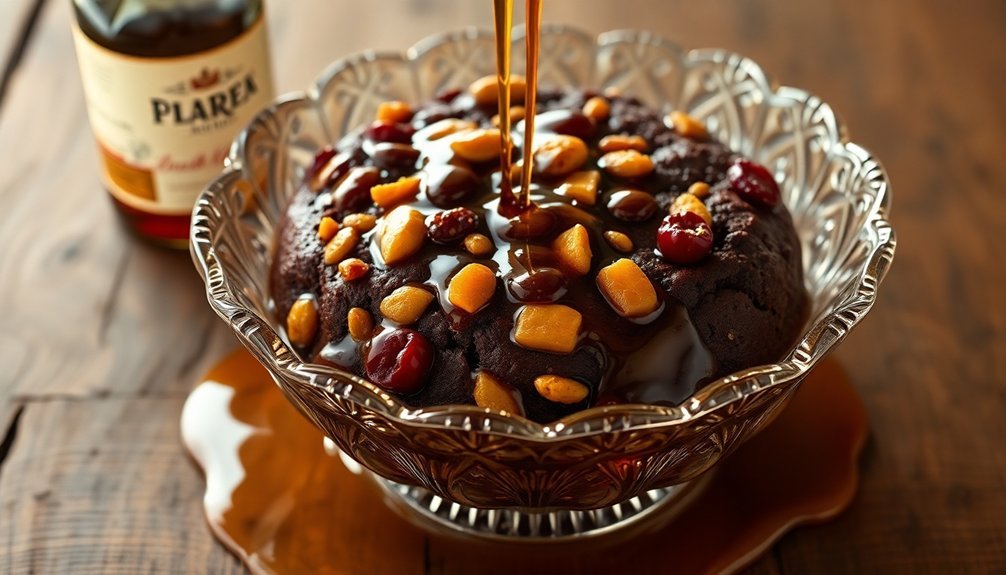
Starting your fruitcake's preservation journey, the initial brandy soak serves as a critical foundation for developing rich flavors and guaranteeing long-term storage. You'll need to prepare your dried fruits by sorting, cleaning, and slicing them to uniform sizes—about 1 cm for most fruits, slightly larger for dates.
Place your prepared fruits in a glass or ceramic container with a tight-fitting lid. Pour high-quality brandy over the fruits until they're completely covered, starting with half a cup. You'll need to stir the mixture daily or every other day to guarantee even distribution of the brandy.
| Fruit Type | Size Guide | Special Notes |
|---|---|---|
| Raisins | 1 cm | Keep whole if small |
| Dates | 1.5 cm | Slice slightly larger |
| Cranberries | 1 cm | Halve if too large |
Store your soaking fruits in a dark place at room temperature. If you're using a non-alcoholic alternative, keep the container refrigerated. Monitor the fruit regularly, adding more brandy when needed to maintain moisture. While overnight soaking works, extending the process to a week or longer will greatly enhance the flavors.
Proper Wrapping Techniques
Successful fruitcake preservation hinges on three essential wrapping techniques that work together to lock in moisture and flavor.
The first method uses brandy-soaked cheesecloth, which you'll need to cut large enough to wrap around your fruitcake completely. After soaking the cloth in brandy, wring out the excess to prevent dripping, then wrap it tightly around your cake.
For the second layer, you'll want to use plastic wrap to create an airtight seal. Make sure you're wrapping it tightly to prevent any air pockets. You can add parchment paper and foil for extra protection against moisture loss and environmental factors.
To maintain your wrapped fruitcake, you'll need to check the cheesecloth weekly for dryness. When it feels dry, resoak it with brandy or your chosen liquor. Use a spray bottle to apply 1-2 teaspoons of liquor every few days, ensuring even distribution.
You'll want to store your wrapped fruitcake in a cool, dry place or refrigerate it for extended aging. If you're planning to freeze it, wait at least four weeks after baking to allow the flavors to develop fully.
Storage Environment Requirements
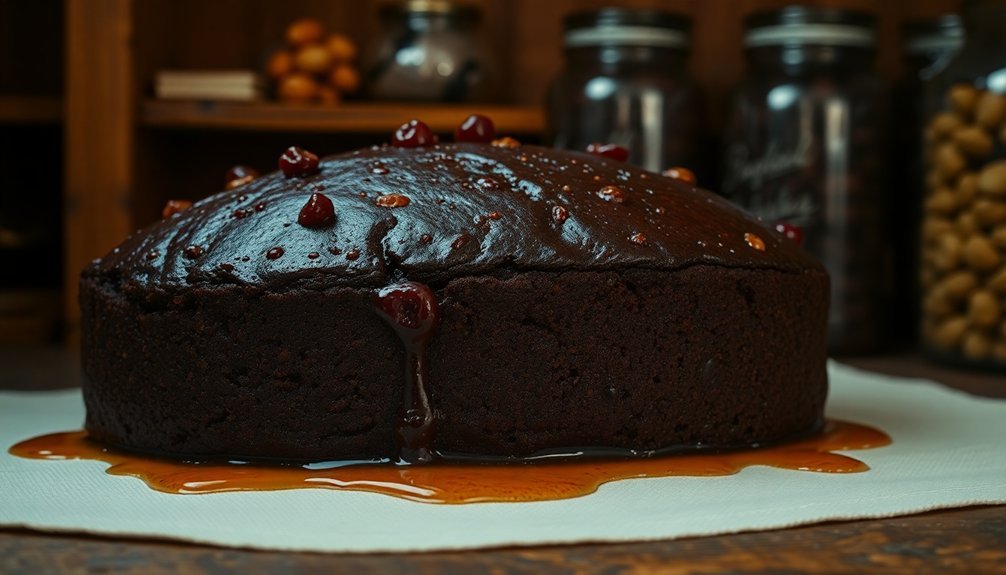
Once your fruitcake is properly wrapped, selecting the right storage environment will determine how well it ages and develops its complex flavors.
You'll need to store your fruitcake in a cool, dark place away from direct sunlight to maintain its texture and taste. A cabinet, pantry, or cellar with stable temperature conditions works perfectly for this purpose.
While room temperature storage is fine for up to four weeks, you'll get better results in cooler environments that slow down the aging process. Your storage area should be consistently dry to prevent mold growth, even though you're using liquor-soaked cheesecloth.
If you're planning to store your fruitcake for several months, you can keep it in the refrigerator, where it'll stay fresh for up to two months.
For long-term preservation, you have two options: continue storing in a cool, dry place where the cake can age naturally, or freeze it after it has aged for at least four weeks.
Remember to check your fruitcake periodically to guarantee it maintains proper moisture levels. With proper storage conditions, your fruitcake will continue to develop richer, more complex flavors over time.
Feeding Schedule and Methods
Feeding your fruitcake with brandy requires a careful balance of timing and technique to achieve the perfect moisture level and flavor.
You'll need to start immediately after baking, then space out subsequent feeds every 1-2 weeks, with a maximum of four feeds during the maturation period.
You can choose from several effective methods to feed your cake. You might wrap it in brandy-soaked cheesecloth, poke holes with a skewer and pour the brandy directly, or use a spray bottle for even distribution.
If you're using cheesecloth, remember to check it weekly and resoak as needed to maintain moisture.
When it comes to alcohol selection, stick to strong spirits like brandy, rum, or whisky.
Apply 1-2 teaspoons per feed, or if you're looking for a more intense flavor, use up to 2 tablespoons every two weeks. You can customize the taste by selecting different spirits – try orange liqueur for a citrus note.
Keep your cake tightly wrapped between feeds and store it in a cool, dry place.
You'll want to monitor its condition regularly and adjust your feeding schedule if you notice it becoming too wet or dry.
Signs of Proper Aging
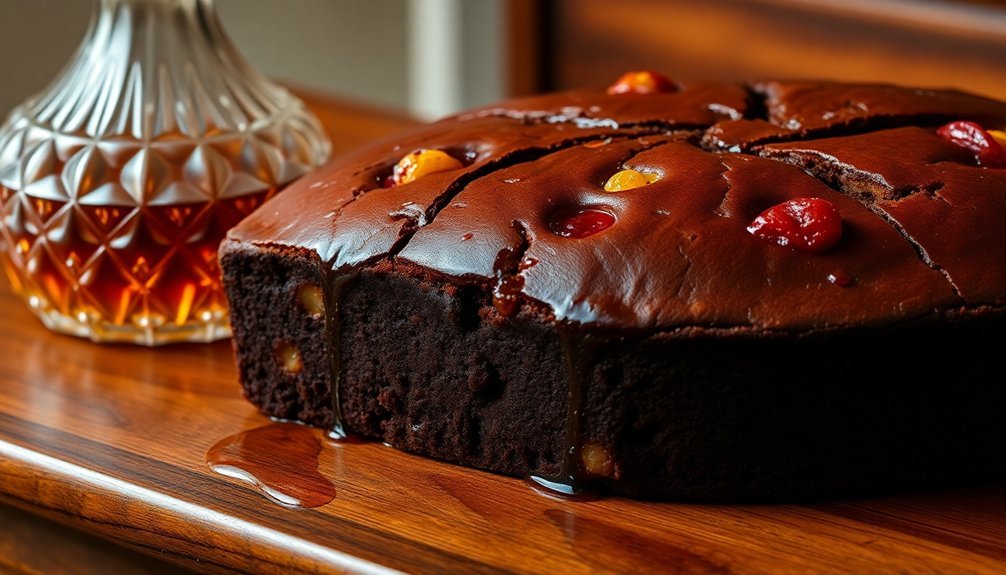
You'll notice significant changes in your aging fruitcake as it transforms from a freshly baked cake to a properly matured delicacy, starting with its gradual darkening and increasing density.
The aroma will become more complex and intense over time, with the fruits and spirits creating a harmonious bouquet that signals proper aging.
Your fruitcake's ability to absorb and retain brandy will improve as it ages, resulting in a moist, rich texture that's characteristic of a well-preserved specimen.
Color and Texture Changes
Proper aging of a fruitcake reveals itself through several distinct changes in both color and texture.
You'll notice the cake gradually darkening as it absorbs the brandy, especially if you're using liquor aged in charred oak barrels. Dark fruits like currants and prunes, combined with molasses, contribute to this rich coloration, which intensifies as the cake matures and soaks up more brandy.
The texture of your fruitcake will transform notably during the aging process. Through regular brandy applications, you'll feel the cake becoming denser and moister.
Steam treatments can help open the cake's pores, allowing it to absorb the flavors and moisture more effectively. You'll want to wrap the cake in cheesecloth and aluminum foil to maintain this newfound moisture and prevent bacterial growth.
You can confirm proper aging by looking for an even, dark color across the surface and a slight sheen that indicates good moisture retention.
When you lift the cake, it should feel heavy and dense. If you notice any cracks or lighter patches, it's time to feed your cake more brandy. The absence of damp patches underneath suggests you've achieved the right moisture balance.
Aroma Development Stages
Throughout the aging process, your fruitcake will develop distinct aromatic stages that signal proper maturation. Initially, you'll notice strong individual aromas from the dried fruits, nuts, spices, and alcohol. The brandy's scent will be particularly prominent, accompanied by distinct notes of cinnamon, nutmeg, and citrus elements.
As your fruitcake matures, these individual aromas begin to meld together. You'll observe the alcohol notes deepening and integrating with the fruit and spice fragrances, creating a more complex and sophisticated profile. The nutty aromas become subtler while remaining discernible, and the overall scent grows richer as moisture content stabilizes.
After several weeks or months, your fruitcake will reach its peak aroma development. At this stage, you'll experience a flawless balance where no single ingredient dominates. The sweetness from honey and molasses becomes more pronounced, while the spices mature and blend seamlessly with other scents.
With proper maintenance, including regular brandy applications, you can maintain this ideal aroma profile for months. The alcohol acts as a preservative, ensuring your fruitcake's scent remains stable and free from spoilage, contributing to its long-term enjoyment.
Liquor Absorption Patterns
While monitoring your fruitcake's aroma development, you'll also want to track its liquor absorption patterns. You'll notice the initial absorption happens quickly as the brandy soaks through the surface, especially when you've wrapped your cake in alcohol-soaked cheesecloth. This first stage is essential for both moisture and flavor development, while the alcohol acts as a natural preservative.
You'll need to feed your fruitcake weekly to maintain proper moisture levels. Use a spray bottle for even distribution and poke holes throughout to guarantee the brandy reaches the bottom. Check your cheesecloth wrapping weekly – it should remain consistently damp, not dry.
For proper storage, you'll want to wrap your cake in multiple protective layers. Start with the cheesecloth, followed by aluminum foil (making sure they don't touch), and finish with a plastic bag. Place it in a cake tin with a tight-fitting lid in a cool, dry spot.
During long-term aging, which can last up to a year or more, you'll continue periodic brandy applications until the cake reaches saturation. After 6-8 months, consider transferring it to the refrigerator to maintain ideal freshness.
Serving Your Preserved Fruitcake
After months of careful preservation, your brandy-soaked fruitcake offers countless serving possibilities that go far beyond traditional holiday desserts. You'll find this versatile treat can transform into elegant hors d'oeuvres, hearty breakfast options, or sophisticated desserts.
| Meal Type | Serving Suggestions |
|---|---|
| Breakfast | Make French toast with eggnog batter, or toast and top with honey walnut cream cheese |
| Dessert | Pair with ice cream, drizzle with brandy sauce, or frost with marzipan |
| Appetizers | Serve 1-inch cubes with aged cheddar or create chocolate-covered truffles |
| Toppings | Crumble over yogurt, oatmeal, or ice cream for added texture |
| Creative Uses | Layer in trifles or incorporate into bread pudding |
Your preserved fruitcake's rich, brandy-infused flavor works exceptionally well in both sweet and savory applications. For breakfast, try transforming slices into French toast or topping them with cream cheese. When entertaining, create an elegant cheese board by pairing fruitcake cubes with fine cheeses and wine. For dessert, you can't go wrong with a classic presentation – simply slice and serve, or elevate it with whipped cream and a brandy sauce drizzle.
Frequently Asked Questions
Can I Use Homemade Brandy Instead of Store-Bought for Preserving Fruitcake?
You can use homemade brandy to preserve fruitcake if it's properly distilled and has at least 35% alcohol content. You'll need to guarantee it's filtered well to avoid impurities affecting the cake's flavor.
What Happens if I Accidentally Oversoak My Fruitcake With Brandy?
If you've oversoaked your fruitcake with brandy, you'll notice it becomes soggy and falls apart easily. The flavor will be overwhelmingly boozy, masking other ingredients, and your cake's texture won't hold up well when sliced.
Is It Safe to Give Brandy-Preserved Fruitcake to Children?
No, you shouldn't give brandy-preserved fruitcake to children. The alcohol content can be harmful to minors, even in small amounts. It's best to make a non-alcoholic version using fruit juice instead.
Can I Mix Different Types of Liquor When Preserving My Fruitcake?
You can mix different liquors when preserving fruitcake, but it's best to choose compatible ones and stick to a consistent ratio. Remember that mixing multiple liquors will create unique flavors requiring careful balance.
Will Altitude Affect the Aging Process of My Brandy-Preserved Fruitcake?
You don't need to worry about altitude affecting your brandy-preserved fruitcake's aging process. As long as you're storing it properly in a cool, dry place and maintaining regular brandy applications, it'll age beautifully.
In Summary
By following these traditional preservation methods, you'll have a flavorful fruitcake that can last for months or even years. Remember to maintain your feeding schedule and check regularly for proper aging signs. When it's time to serve, you'll be rewarded with a rich, moist cake that's perfectly infused with brandy. Don't forget to store any leftover cake properly to continue the preservation process.

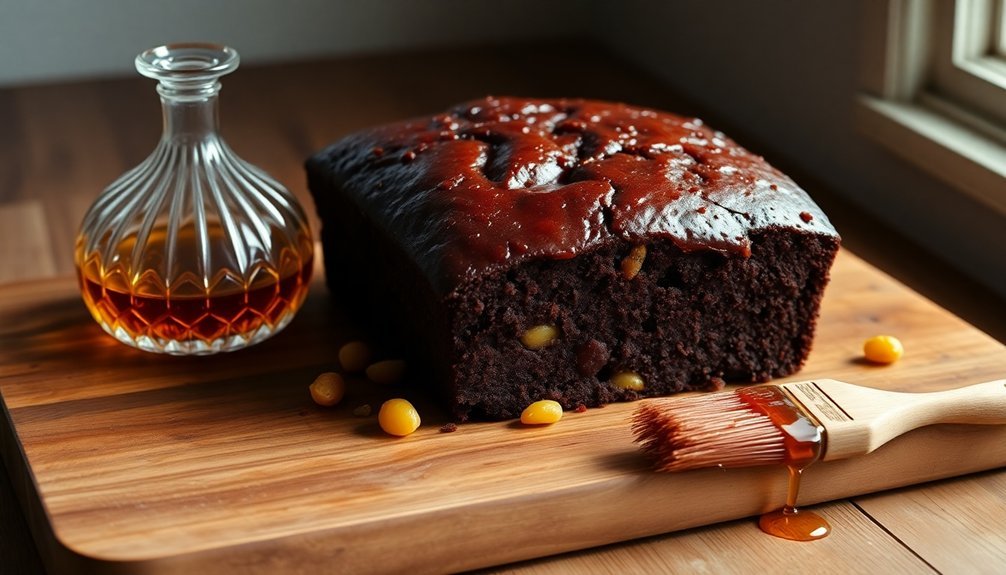



Leave a Reply